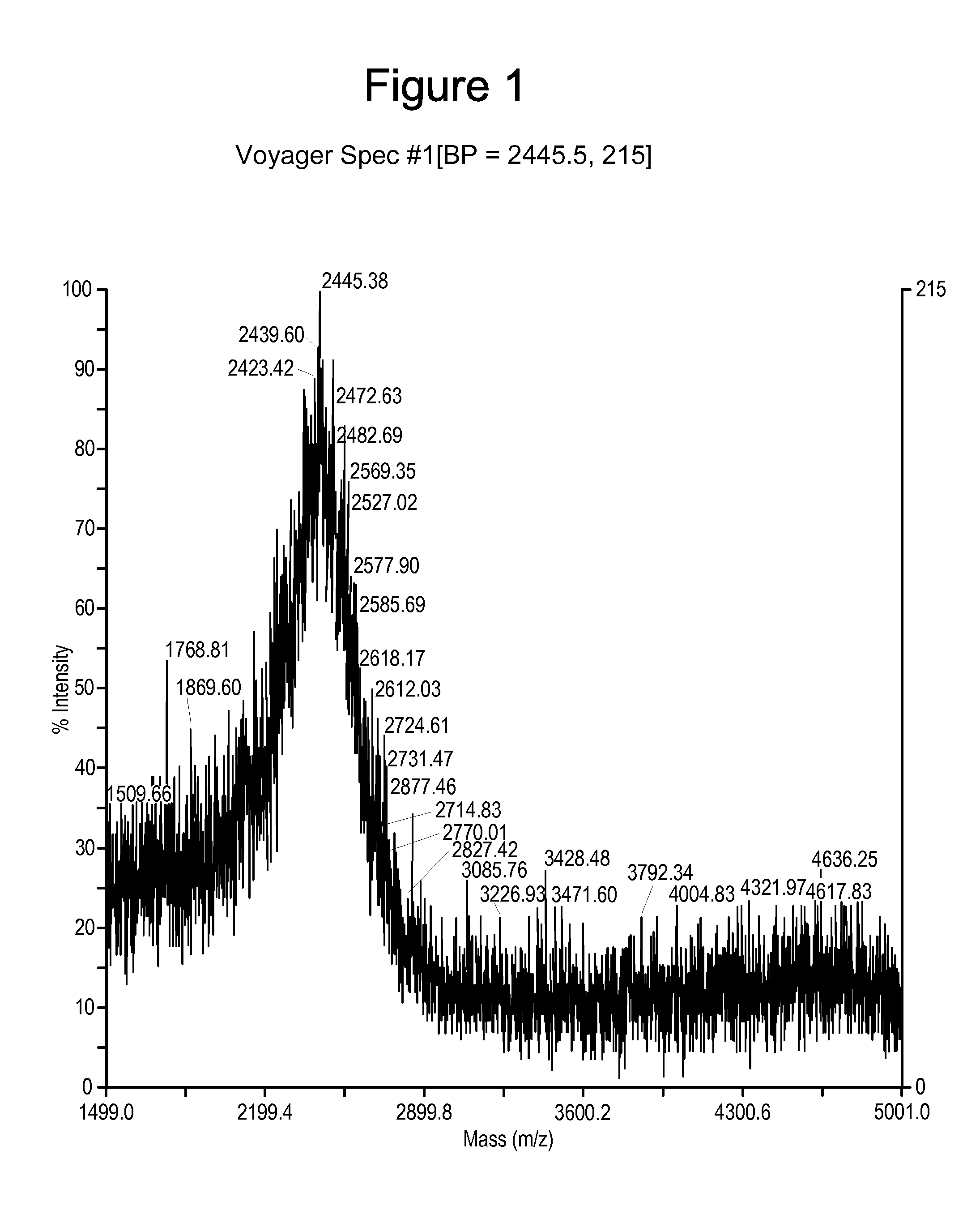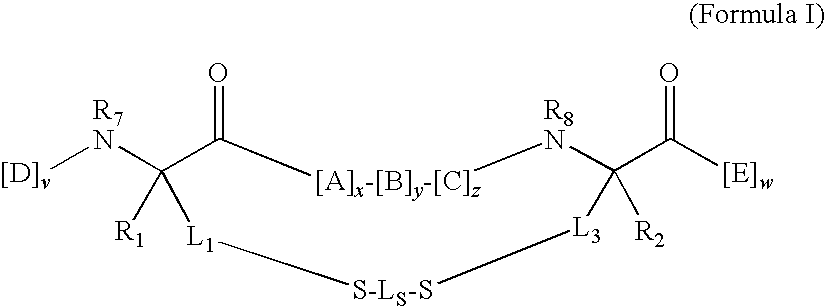Bis-sulfhydryl macrocyclization systems
a macrocyclization and sulfhydryl technology, applied in the field of bissulfhydryl macrocyclization systems, can solve the problems of poor metabolic stability, poor cell penetration, promiscuous binding, etc., and achieve the effect of improving biological properties
- Summary
- Abstract
- Description
- Claims
- Application Information
AI Technical Summary
Benefits of technology
Problems solved by technology
Method used
Image
Examples
example 1
[0268]Synthesis of a peptidomimetic macrocycle. The target molecule is the BID-BH3 peptide with amino acids 12 and 16 replaced by Cysteine (see Table 1 and Table 6). The Cysteine side chain thiols were then derivatized with 1,4-dibromobutane to form the bis-thioether peptidomimetic macrocycle (DIIRNIARHLACVGDCNLDRSI is
[0269]
disclosed as SEQ ID NO: 99).
[0270]Following the general peptide synthetic strategy described, the peptidomimetic precursor was a polypeptide of the sequence DIIRNIARHLACVGDCNLDRSI (SEQ ID NO: 100) (where “NL” or “Nle” represent norleucine) synthesized at 0.2 mmol scale on a PTI-Ranin PS3 single channel synthesizer using the following coupling cycles for each amino acid:
[0271]
Deprotection20% piperidine in DMF 2 × 7 minWashDMF 6 × 0.5 minCoupling5 fold excess each of amino acid, TBTU and DIEA inDMF 1 × 20 minWashDMF 2 × 0.5 minCoupling5 fold excess each of amino acid, TBTU and DIEA inDMF 1 × 20 minWashDMF 6 × 0.5 min
example 2
[0272]Synthesis of a peptidomimetic macrocycle comprising α,α-disubstituted amino acids. The target molecule is the BID-BH3 peptide with amino acids 12 and 16 replaced by α-methylcysteine (see Synthetic Scheme 5, Table 1 and Table 6). The α-methylcysteine side chain thiols were then derivatized with 1,4-dibromobutane to form the bis-thioether peptidomimetic macrocycle shown in Synthetic Scheme 5.
[0273]The target peptidomimetic macrocycle was synthesized using a combination of automated (Thuramed TETRAS multi-channel synthesizer) and manual techniques as outlined below. The following amino acids were used in the synthesis of the peptidomimetic macrocycle: Fmoc-Ala-OH, Fmoc-Arg(Pbf)-OH, Fmoc-Asp(tBu)-OH, Fmoc-α-Me-Cys(Mmt)-OH (Ricerca, Concord, Ohio), Fmoc-Gly-OH, Fmoc-His(Trt)-OH, Fmoc-Ile-OH, Fmoc-Leu-OH, Fmoc-Nle-OH, Fmoc-Asn(Trt)-OH, Fmos-Ser(tBu), Fmoc-Val-OH. All amino acids were obtained from Creosalus Inc. (Louisville, Ky.) except as noted.
[0274]Automated deprotection of Fmoc-...
PUM
| Property | Measurement | Unit |
|---|---|---|
| pH | aaaaa | aaaaa |
| Tm | aaaaa | aaaaa |
| temperature | aaaaa | aaaaa |
Abstract
Description
Claims
Application Information
 Login to View More
Login to View More - R&D
- Intellectual Property
- Life Sciences
- Materials
- Tech Scout
- Unparalleled Data Quality
- Higher Quality Content
- 60% Fewer Hallucinations
Browse by: Latest US Patents, China's latest patents, Technical Efficacy Thesaurus, Application Domain, Technology Topic, Popular Technical Reports.
© 2025 PatSnap. All rights reserved.Legal|Privacy policy|Modern Slavery Act Transparency Statement|Sitemap|About US| Contact US: help@patsnap.com



